
Coins on this page are arranged from the most valuable to the least valuable, and they are also shown in four major groups. Coins closer to the top of the page, and coins closer to the top of a group, command higher values than coins in lower positions. To look up specific coins, use the search functions on this web site. This page gives general values.
Some coins have special dates and mint marks that increase their value, some coins derive value from their pristine state of preservations (called uncirculated coins). Heavily worn or damaged coins are always worth less than specimens showing average wear. Do not worry if your coin does not look exactly like the one pictured or is large or small in size. There are several varieties of many of these coins.
 To properly understand German coinage, one must understand the history of Germany, the German States, and German cities. Before the Empire congealed under Prussian chancellor Otto vo Bismarck in 1871, dozens of autonomous German States and German cities issued thousands of different types of coins in many different monetary units. Inscriptions of DEUTSCHES (German), BUNDES (nation), or REICH (empire) indicate German origins. Further, German names often contain VON (meaning "of") and you will see this annotation when a coin commemorates a particular German ruler.
To properly understand German coinage, one must understand the history of Germany, the German States, and German cities. Before the Empire congealed under Prussian chancellor Otto vo Bismarck in 1871, dozens of autonomous German States and German cities issued thousands of different types of coins in many different monetary units. Inscriptions of DEUTSCHES (German), BUNDES (nation), or REICH (empire) indicate German origins. Further, German names often contain VON (meaning "of") and you will see this annotation when a coin commemorates a particular German ruler.
Look at the bottom of this page. You will find a long list of German states, cities, and coin denominations. If you see any one of these on a coin, it is probably from Germany.
Coins in this group range in value from thousands of dollars down to hundreds of dollars. Unless they are heavily worn or have significant damage like scratches, spots, or stains, these coins command high premium values and must be treated with care. Never clean a coin. Cleaning ruins value.
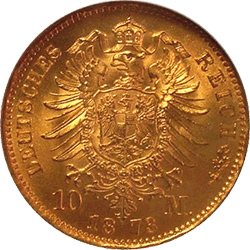 Early German Gold - There are many different varieties of early German gold coins from the German States and German cities. No two are alike. Some look like the coin in the picture, most do not. All command high value from their gold content and intrinsic age and beauty. The dates after 1871 usually carry mark denominations, such as 10 mark and 20 mark. Before 1871 a variety of denominations appear in gold, such as the ducat, gulden, krone, and thaler.
Early German Gold - There are many different varieties of early German gold coins from the German States and German cities. No two are alike. Some look like the coin in the picture, most do not. All command high value from their gold content and intrinsic age and beauty. The dates after 1871 usually carry mark denominations, such as 10 mark and 20 mark. Before 1871 a variety of denominations appear in gold, such as the ducat, gulden, krone, and thaler.
 50 Reichspfennig of 1924 and 1925 - The German Weimar Republic of 1918 to 1933 issued a very few 50 reichspfennig pieces in aluminum-bronze and these are very valuable because of the low mintage. Other issues carry the same wheat pattern and are not nearly as valuable. There is a 50 rentenpfennig piece with a date and mint mark of 1923J that is about as valuable as the reichspfennig pieces.
50 Reichspfennig of 1924 and 1925 - The German Weimar Republic of 1918 to 1933 issued a very few 50 reichspfennig pieces in aluminum-bronze and these are very valuable because of the low mintage. Other issues carry the same wheat pattern and are not nearly as valuable. There is a 50 rentenpfennig piece with a date and mint mark of 1923J that is about as valuable as the reichspfennig pieces.
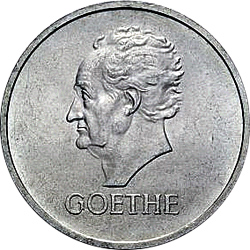 Goethe 5 Reichsmark - The 100th anniversary of the death of Johann Wolfgang von Goethe, a famous German writer, prompted the 1932 issue of a 5 reichsmark piece which is very valuable today. There is a 3 reichmark piece which looks similar, but is worth less.
Goethe 5 Reichsmark - The 100th anniversary of the death of Johann Wolfgang von Goethe, a famous German writer, prompted the 1932 issue of a 5 reichsmark piece which is very valuable today. There is a 3 reichmark piece which looks similar, but is worth less.
Coins in this group range in value from hundreds of dollars down to a few tens of dollars, unless, like all coins, they are heavily worn or have significant damage like scratches, spots, or stains. Never clean a coin. Cleaning ruins value. There are several varieties of many of these coins.
 German Silver up to the Early 1900s - The coin pictured is a well worn large thaler from the German State of Bavaria. Even with the wear, it is a valuable coin. There are several hundred different varieties of early German silver coinage which are worth many tens of dollars. Early large silver coins can sometimes reach the $1000 mark if they are in superb numismatic condition.
German Silver up to the Early 1900s - The coin pictured is a well worn large thaler from the German State of Bavaria. Even with the wear, it is a valuable coin. There are several hundred different varieties of early German silver coinage which are worth many tens of dollars. Early large silver coins can sometimes reach the $1000 mark if they are in superb numismatic condition.
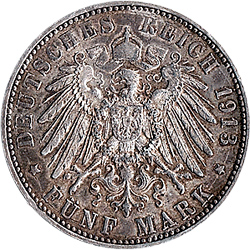 Silver 2, 3, and 5 Marks after 1871 - Even though the German Empire adopted a unified monetary system in 1871, many German States continued to issue their own 2, 3, and 5 mark coins in silver. These are worth many tens of dollars in average condition, and can easily reach toward $1000 in well preserved condition.
Silver 2, 3, and 5 Marks after 1871 - Even though the German Empire adopted a unified monetary system in 1871, many German States continued to issue their own 2, 3, and 5 mark coins in silver. These are worth many tens of dollars in average condition, and can easily reach toward $1000 in well preserved condition.
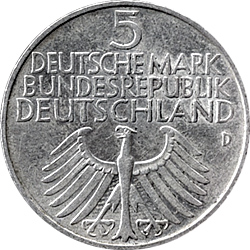 Commemorative 5 Mark Issues of 1952, 55, 57, and 64 - Starting in 1952, the Federal Republich of Germany issued 5 mark pieces commemorating a long series of people, places, and events. Of the dozens of such coins issued, only speciments from 1952, 1955, 1957, and 1964 are valuable. These commemorate the Nurnberg Museum, Friedrich von Schiller, Ludwig von Baden, Joseph Freiherr von Eichendorff, and Johann Gottlieb Fichte, respectively. The remainder of these 5 mark pieces, as well as 10 mark issues, command only a few dollars in value.
Commemorative 5 Mark Issues of 1952, 55, 57, and 64 - Starting in 1952, the Federal Republich of Germany issued 5 mark pieces commemorating a long series of people, places, and events. Of the dozens of such coins issued, only speciments from 1952, 1955, 1957, and 1964 are valuable. These commemorate the Nurnberg Museum, Friedrich von Schiller, Ludwig von Baden, Joseph Freiherr von Eichendorff, and Johann Gottlieb Fichte, respectively. The remainder of these 5 mark pieces, as well as 10 mark issues, command only a few dollars in value.
 Certain 2, 3, and 5 Reichsmark Issues from 1925 to 1932 - Most of the 2, 3, and 5 reichsmark coins from 1925 to 1930 carry decent numismatic value. Of particular note are 1927D 2 reichsmark, 1922D, 1927F, and 1928D 3 reichsmark, all mint marks of 1931, 32, and 33 3 reichsmark, 1927 Bremerhaven and 1927 Tubingen 5 reichsmarks. The latter coin is pictured. These coins catalog in the 100s of dollars.
Certain 2, 3, and 5 Reichsmark Issues from 1925 to 1932 - Most of the 2, 3, and 5 reichsmark coins from 1925 to 1930 carry decent numismatic value. Of particular note are 1927D 2 reichsmark, 1922D, 1927F, and 1928D 3 reichsmark, all mint marks of 1931, 32, and 33 3 reichsmark, 1927 Bremerhaven and 1927 Tubingen 5 reichsmarks. The latter coin is pictured. These coins catalog in the 100s of dollars.
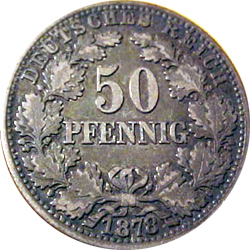 50 Pfennig Coins of 1878 through 1903 - These old pieces from the German Empire command high value due to their low mintages. Earlier 50 pfennig coins are valuable also, but about one-tenth value of those with dates 1878 to 1903. Further, 50 pfennig pieces with the following dates and mint marks can climb into the $100 range: 1875E, 1875H, and 1877H.
50 Pfennig Coins of 1878 through 1903 - These old pieces from the German Empire command high value due to their low mintages. Earlier 50 pfennig coins are valuable also, but about one-tenth value of those with dates 1878 to 1903. Further, 50 pfennig pieces with the following dates and mint marks can climb into the $100 range: 1875E, 1875H, and 1877H.
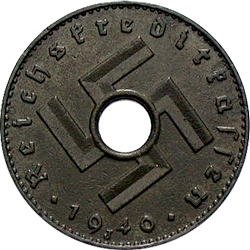 Third Reich Military Issues of 1940 and 1941 - Most of Hitler's Third Reich coins with a swastika carry very little numismatic value. These military issues, minted in zinc, are an exception. The 5 reichspfennig has a hole. The 10 reichspfennig does not.
Third Reich Military Issues of 1940 and 1941 - Most of Hitler's Third Reich coins with a swastika carry very little numismatic value. These military issues, minted in zinc, are an exception. The 5 reichspfennig has a hole. The 10 reichspfennig does not.
 Martin Luther 5 Reichsmark - This coin was issued by Hitler's Third Reich in extremely low mintages. Because they are so rare, they command high value.
Martin Luther 5 Reichsmark - This coin was issued by Hitler's Third Reich in extremely low mintages. Because they are so rare, they command high value.
 3 and 5 Reichsmark Coins of 1925 to 1932 - The German Weimar Republic (1918 to 1933) issued several different 3 and 5 reichsmark pieces from 1925 to 1932 in 50 percent silver. In good condition they command strong value.
3 and 5 Reichsmark Coins of 1925 to 1932 - The German Weimar Republic (1918 to 1933) issued several different 3 and 5 reichsmark pieces from 1925 to 1932 in 50 percent silver. In good condition they command strong value.
These coins sometimes climb into the $100 range, but most are worth a few dollars or a few tens of dollars. High states of preservation work in your favor; heavy wear and problems work against you. Don't worry if your coin does not look exactly like the one pictured.
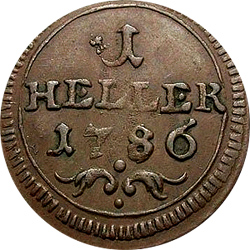 Early German Copper before 1871 - Copper coins, in general, command less value than gold or silver coins. But, if they are early enough and in good condition, they do well in collector value. Many small denomination coins, like this 1 Heller piece from Bamberg, as well as most pfennigs fall into this category.
Early German Copper before 1871 - Copper coins, in general, command less value than gold or silver coins. But, if they are early enough and in good condition, they do well in collector value. Many small denomination coins, like this 1 Heller piece from Bamberg, as well as most pfennigs fall into this category.
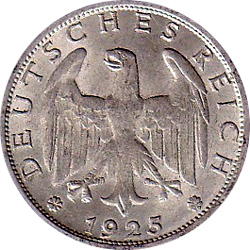 Mark, Reichsmark, and 2 Reichsmark from 1924 to 1931 - These coins are 50 percent silver and command good numismatic premiums.
Mark, Reichsmark, and 2 Reichsmark from 1924 to 1931 - These coins are 50 percent silver and command good numismatic premiums.
 1945 to 1948 Reichspfennig from the Allied Occupation - After the fall of Nazi Germany, Allied forces occupied Germany. The issued coinage used patterns similar to that of the Third Reich, but with the swastika removed. These pieces command a small but decent value. A 10 reichspfennig piece dated 1947 and also bearing an E mint mark is quite valuable, moving towards the 100s of dollars. Other 1, 5, and 10 reichspfennigs from this era can often be worth 10s of dollars if they are in good condition.
1945 to 1948 Reichspfennig from the Allied Occupation - After the fall of Nazi Germany, Allied forces occupied Germany. The issued coinage used patterns similar to that of the Third Reich, but with the swastika removed. These pieces command a small but decent value. A 10 reichspfennig piece dated 1947 and also bearing an E mint mark is quite valuable, moving towards the 100s of dollars. Other 1, 5, and 10 reichspfennigs from this era can often be worth 10s of dollars if they are in good condition.
 Wheat-backed Rentenpfennig and Reichspfennig - The 1924 and 1925 50 reichspfennig issues are called out above as very valuable. Most other pieces with the wheat design command much lower prices, including 5 and 10 rentenpfennig and reichspfennig coins, which can go as low in value as a few cents each. Exceptions to this low-value rule are the following dates and mint marks, which have higher values: 1923F and 1923G 5 rentenpfennig, 1923F and 1925F 10 rentenpfennig, and 1932G 10 reichspfennig.
Wheat-backed Rentenpfennig and Reichspfennig - The 1924 and 1925 50 reichspfennig issues are called out above as very valuable. Most other pieces with the wheat design command much lower prices, including 5 and 10 rentenpfennig and reichspfennig coins, which can go as low in value as a few cents each. Exceptions to this low-value rule are the following dates and mint marks, which have higher values: 1923F and 1923G 5 rentenpfennig, 1923F and 1925F 10 rentenpfennig, and 1932G 10 reichspfennig.
 1, 2, 5, 10, 20, and 25 Pfennigs, and 1/2 and 1 Marks before 1918 - This category represents a large number of early German coins which are quite common and command little value. The imperial eagle design is readily apparent on all but a few varieties, notably the 25 pfennig pieces of 1909 through 1912 which has a wheat-based design. These coins were made of copper, aluminum, iron, zinc, and nickel throughout there long history. Marks and 20 pfennig pieces between 1873 and 1877 contain silver, and are therefore somewhat more valuable. Key dates and mint marks in this series are the exceptions, and can be worth 100s of dollars in good condition, as follows: 1873 1 pfennig, 1877B 1 pfennig, 1902J 1 pfennig, 1916G 1 pfennig, 1873F 2 pfennig, 1896G 5 pfennig, 1873H 10 pfennig, 1892J 10 pfennig, 1915A 10 pfennig, 1916 an 1917 10 pfennig in zinc (not in iron), 1918D 10 pfennig, 1873E 20 pfennig, 1873H 20 pfennig, and 1877H 20 pfennig.
1, 2, 5, 10, 20, and 25 Pfennigs, and 1/2 and 1 Marks before 1918 - This category represents a large number of early German coins which are quite common and command little value. The imperial eagle design is readily apparent on all but a few varieties, notably the 25 pfennig pieces of 1909 through 1912 which has a wheat-based design. These coins were made of copper, aluminum, iron, zinc, and nickel throughout there long history. Marks and 20 pfennig pieces between 1873 and 1877 contain silver, and are therefore somewhat more valuable. Key dates and mint marks in this series are the exceptions, and can be worth 100s of dollars in good condition, as follows: 1873 1 pfennig, 1877B 1 pfennig, 1902J 1 pfennig, 1916G 1 pfennig, 1873F 2 pfennig, 1896G 5 pfennig, 1873H 10 pfennig, 1892J 10 pfennig, 1915A 10 pfennig, 1916 an 1917 10 pfennig in zinc (not in iron), 1918D 10 pfennig, 1873E 20 pfennig, 1873H 20 pfennig, and 1877H 20 pfennig.
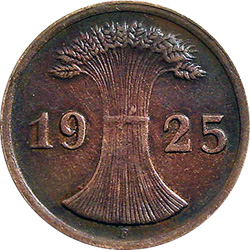 Rentenpfennigs and reichspfennigs between WWI and WWII - These coins were issued in bronze and carry small but decent value. The exceptional dates and mint marks, worth 100s of dollars in good condition, are: 1925A 1 rentenpfennig, 1929F 1 retenpfennig, and 1923F 2 reichspfennig.
Rentenpfennigs and reichspfennigs between WWI and WWII - These coins were issued in bronze and carry small but decent value. The exceptional dates and mint marks, worth 100s of dollars in good condition, are: 1925A 1 rentenpfennig, 1929F 1 retenpfennig, and 1923F 2 reichspfennig.
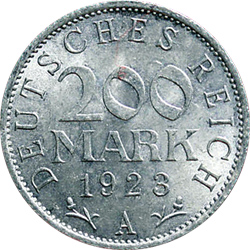 200 and 500 Mark Coins between WWI and WWII - Economic depression aided Hitler in his rise to power. These coins, minted by the millions in aluminum, command essentially no real value today. The 1923J coin has a little value.
200 and 500 Mark Coins between WWI and WWII - Economic depression aided Hitler in his rise to power. These coins, minted by the millions in aluminum, command essentially no real value today. The 1923J coin has a little value.
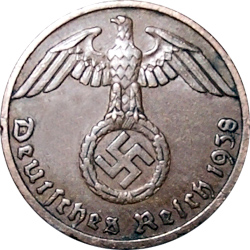 Coins of the Third Reich - Coinage from Hitler's Third Reich span from 1933 to 1945. Most, but not all Third Reich coins display a swastika. All of these coins are worth very little today, except for the Martin Luther and military issues described above. In addition, the following dates and mint marks can carry a repectable value of a few 10s of dollars if they are in good condition: 1936 1 reichspfennig except with A mint mark, 1945E 1 reichspfennig, 1940G 2 reichspfennig, 1936 5 reichspfennig, 1944G 5 reichspfennig, 1936G 10 reichspfennig, 1944G 50 reichspfennig, 1939B and 1939G reichsmark.
Coins of the Third Reich - Coinage from Hitler's Third Reich span from 1933 to 1945. Most, but not all Third Reich coins display a swastika. All of these coins are worth very little today, except for the Martin Luther and military issues described above. In addition, the following dates and mint marks can carry a repectable value of a few 10s of dollars if they are in good condition: 1936 1 reichspfennig except with A mint mark, 1945E 1 reichspfennig, 1940G 2 reichspfennig, 1936 5 reichspfennig, 1944G 5 reichspfennig, 1936G 10 reichspfennig, 1944G 50 reichspfennig, 1939B and 1939G reichsmark.
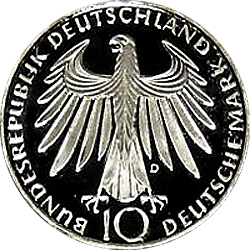 Modern Commemorative Coins - Both East and West Germany, the Demokratische Republik, and the Bundes Republik (Deutschland), repsectively, issued 5 and 10 mark commemorative coins starting in the 1960s and continuing through modern times. These coins show dozens of different designs, and some were issued as proof coins (pictured), some in silver, and some with fancy packaging. Except for the Bundes Republik issues before 1965, mentioned above on this page, all these commemorative coins are worth very small amounts today, usually between one and 10 US dollars. Note that the Demokratische Republik issued 20 mark pieces as well as the 5 and 10 mark coins.
Modern Commemorative Coins - Both East and West Germany, the Demokratische Republik, and the Bundes Republik (Deutschland), repsectively, issued 5 and 10 mark commemorative coins starting in the 1960s and continuing through modern times. These coins show dozens of different designs, and some were issued as proof coins (pictured), some in silver, and some with fancy packaging. Except for the Bundes Republik issues before 1965, mentioned above on this page, all these commemorative coins are worth very small amounts today, usually between one and 10 US dollars. Note that the Demokratische Republik issued 20 mark pieces as well as the 5 and 10 mark coins.
Modern German issues are worth face value, i.e., the value they have in normal commerce, but these coins have been rapidly exchanged for euros as Germany becomes a member of the European Union. Proof coins, which are coins struck especially for collectors and sport mirror-like surfaces, are worth a few dollars more than regular issues. The German Mint also issued modern coins in Mint Sets and Proof Sets. There were made especially for collectors and carry small premium value. When coins are minted in gold or silver, the bullion value applies.
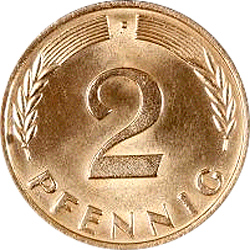 Modern 1, 2, 5, 10, and 50 Pfennig Coins Federal Republic - The Federal Republic (West Germany before 1990) issued these coins in bronze, copper nickel, and steel starting in 1948. They are worth face value.
Modern 1, 2, 5, 10, and 50 Pfennig Coins Federal Republic - The Federal Republic (West Germany before 1990) issued these coins in bronze, copper nickel, and steel starting in 1948. They are worth face value.
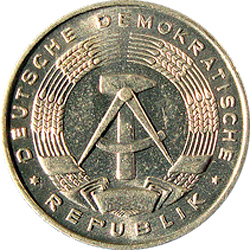 Modern 1, 5, 10, 20, and 50 Pfennig Coins Democratic Republic - The Democratic Republic (East Germany before 1990) issued these coins in alluminum and brass starting in 1948. They are worth face value.
Modern 1, 5, 10, 20, and 50 Pfennig Coins Democratic Republic - The Democratic Republic (East Germany before 1990) issued these coins in alluminum and brass starting in 1948. They are worth face value.
 Modern 1, and 2 Mark Coins Federal Republic - The Federal Republic (West Germany before 1990) issued these coins in copper nickel starting in 1950. There are several different designs, but they all contain the insrciption Deutsche Mark. They are worth face value.
Modern 1, and 2 Mark Coins Federal Republic - The Federal Republic (West Germany before 1990) issued these coins in copper nickel starting in 1950. There are several different designs, but they all contain the insrciption Deutsche Mark. They are worth face value.
 Modern 1, and 2 Mark Coins Democratic Republic - The Democratic Republic (East Germany before 1990) issued these coins in aluminum starting in 1956. They are worth face value.
Modern 1, and 2 Mark Coins Democratic Republic - The Democratic Republic (East Germany before 1990) issued these coins in aluminum starting in 1956. They are worth face value.
If you see any of the following annotations on a coin, it is probably a German coin.
German Cities and States - Aachen, Anhalt, Arenberg, Augsburg, Baden, Bamberg, Bavaria, Bentheim, Biberach, Bocholt, Brandenburg, Braunau, Bremen, Bretzenheim, Brunswick, Buchhorn, Cleves, Coesfeld, Cologne, Constance, Corvey, Crailsheim, Dortmund, East Friesland, Eichstatt, Ellwangen, Emden, Erbach, Erfurt, Essen, Esslingen, Franconian Circle, Frankfurt, Freiburg, Freising, Friedberg, Fugger, Fulda, Furtstenberg, Further Austria, Goslar, Hall, Hamburg, Hamm, Hanau, Heilbronn, Henneberg, Hesse, Hildesheim, Hohenlohe, Hohenzollern, Isny, Jever, Julich-Berg, Kaufbeuren, Kempten, Kirchberg, Konigsegg-Rothenfels, Kosel, Landau, Lauenburg, Leutkirch, Lindau, Lippe-Detmold, Lowenstein, Lubeck, Luneburg, Mainz, Mansfeld, Mecklenburg, Memmingen, Montfort, Muhlhausen, Munster, Nassau, Nurnberg, Oldenburg, Osnabruck, Ottingen, Paderborn, Passau, Pfalz, Pomerania, Prussia, Pyrmont, Quedlinburg, Regensburg, Reuss, Rietberg, Rostock, Rothenburg, Saint Alban, Salm, Saxe, Saxony, Sayn, Schaumburg, Schleswig, Schmalkalden, Schonau, Schwarzburg, Silesia, Sinzendorf, Solms, Speyer, Stolberg, Straslsund, Swabian Circle, Teutonic Order, Thurn and Taxis, Trier, Waldeck, Werden, Wied, Wismar, Worms, Wurttemberg, Wurzburg
German Monetary Denominations - Albus, Carolin, Ciffert, Denar, Doppia, Dreiling, Ducat, Einen, Friedrich D'Or, Goldgulden, Groschen, Grote, Groten, Gulden, Gute Groschen, Heller, Kortling, Kreutzer, Kreuzer, Krone, Leichter Pfennig, Marck, Mariengroschen, Mark, Mattier, Maximilian D'Or, Petermenger, Pfennig, Pfennige, Pistoles, Reichsthaler, Schilling, Schillinge, Schwaren, Sechsling, Sol, Stuber, Thaler, Wilhelm D'Or
About CoinQuest | Privacy Policy | Contact CoinQuest
Copyright 2009 to 2024 CoinQuest.com, all rights reserved.
Daily visitors 233, minutes per visit 6.2, daily coin views 572